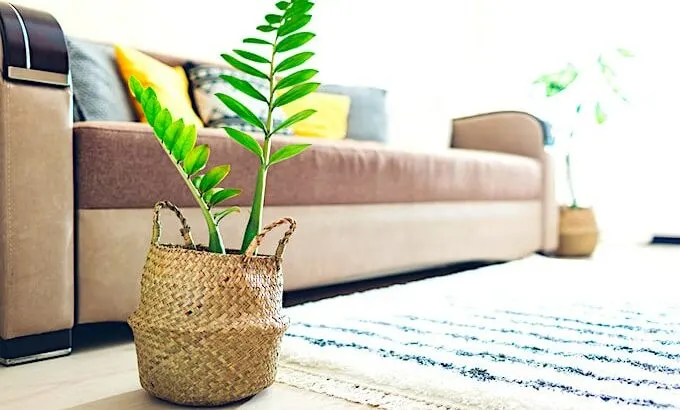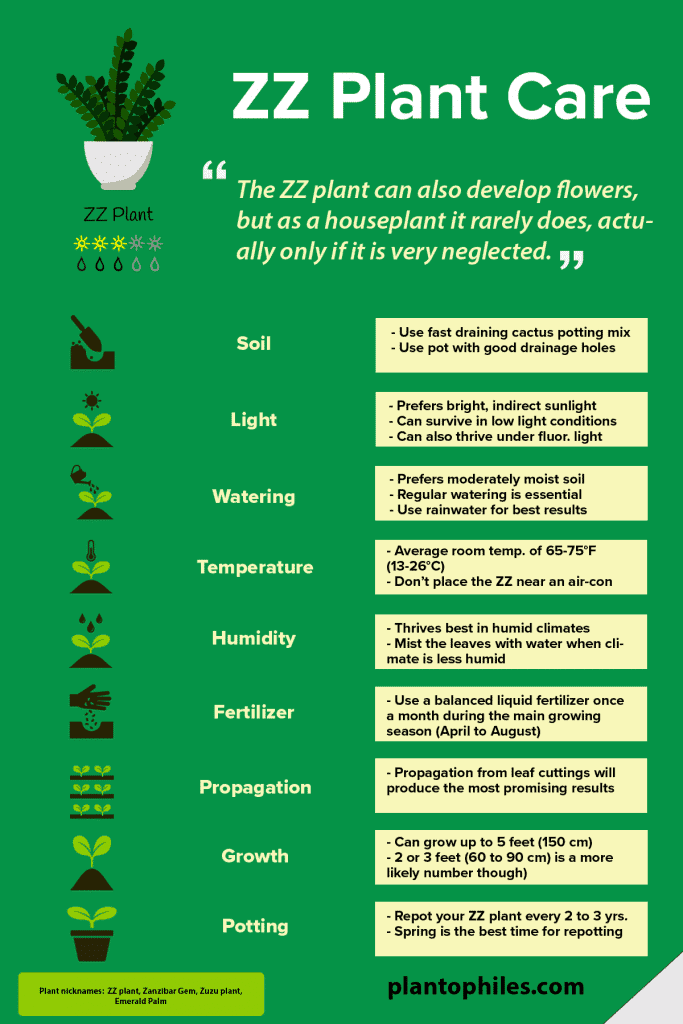The ZZ plant or Zamioculcas Zamiifolia, also known as the Zanzibar gem, is a straightforward and easy-to-care-for houseplant indoors.
It has oval-shaped leaves. The leaves are green and glossy. It grows tubers underneath the ground.
Zz plants are known to thrive in neglect. It grows in darker corners of the house or office and is drought-tolerant.
To provide the best ZZ plant care, read and follow the guide I created below.
Table of Contents
Zamioculcas zamiifolia Takeaways_copy
| Species | Zamioculcas zamiifolia |
| Synonyms | ZZ plant, Aroid plant, Zanzibar Gem, Eternity Plant, Money Tree, Succulent Philodendron, Golden Tree, Fat Boy, Zu Zu plant |
| Family | Araceae |
| Genus | Zamioculcas |
| Growth | Upright stems and dark green glossy leaves. Grows underground rhizomes |
| Height | 5 feet |
| Width | 2 feet |
| Soil | Well-draining soil using cactus soil containing perlite and horticultural sand in a ratio of 1:1 |
| Watering | Every 4 weeks |
| Light | Bright indirect |
| Temperature | 65-75°F (18-24°C) |
| Humidity | 40-50% |
| Fertilizer | Fertilize every two weeks in spring and summer |
| Propagation | Leaf cuttings, division |
| Toxicity | This plant is toxic to cats and dogs as well as humans. All parts are toxic and lead to a burning sensation in the mouth, throat, and tongue. |
ZZ Plant Care
To care for the ZZ plant, provide a temperature between 65 – 75 degrees Fahrenheit (18-24 degrees Celsius) and bright indirect light. Well-draining soil using cactus soil containing perlite and horticultural sand in a ratio of 1:1 works best. Water once a month and provide regular indoor humidity between 40-50%. Fertilize once a month in spring and summer using a diluted liquid houseplant fertilizer.
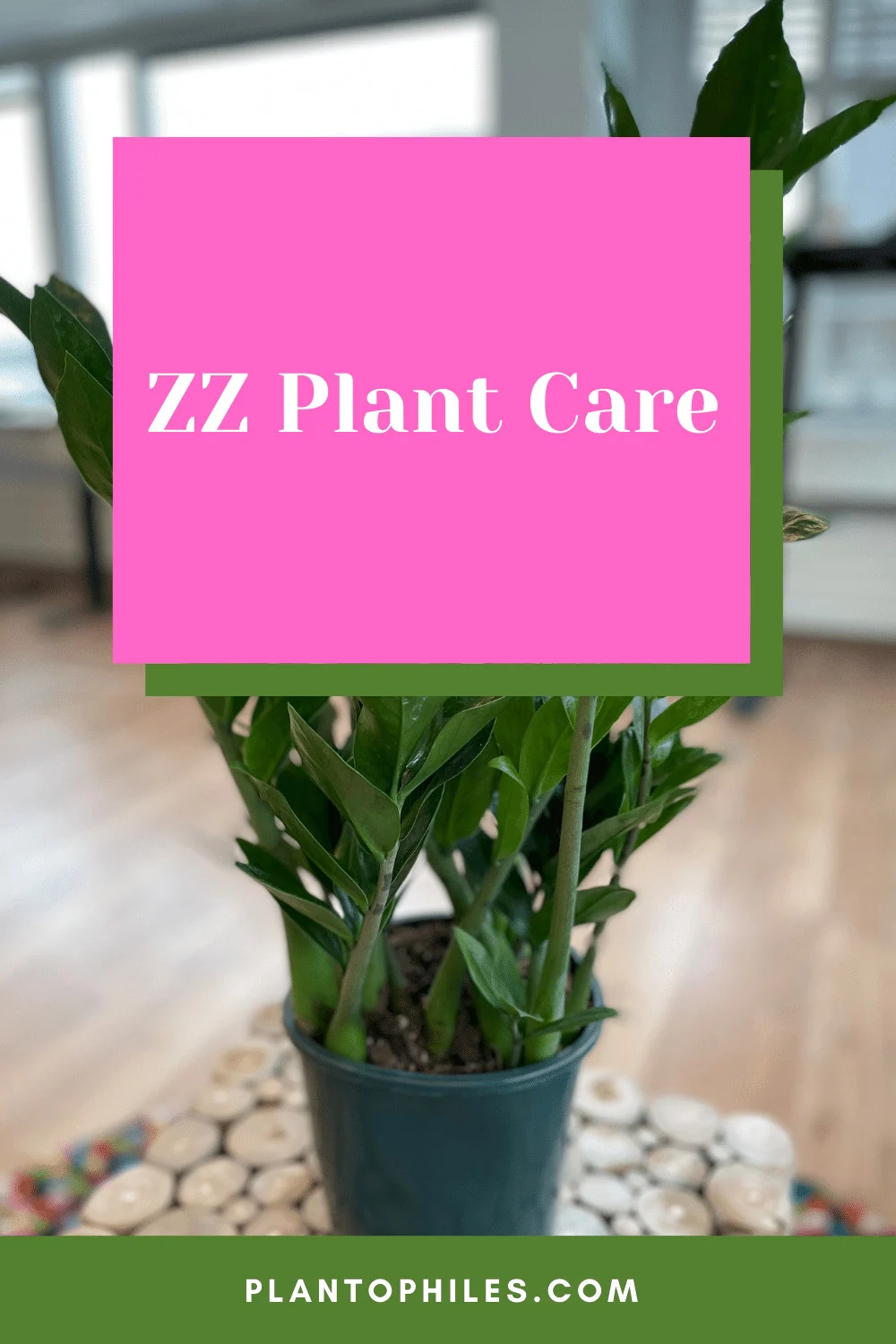
ZZ Plant Care Video
Care for a ZZ Plant – IT is Easy To Grow ZZ Plants
Soil
For the indoor plant, use a well-draining soil mix containing horticultural sand and perlite.
The best soil choice is a fast-draining cactus potting mix.
Mix 1 part of horticultural sand or perlite and 1 part of high-quality all-purpose potting mix to maximize the drainage.
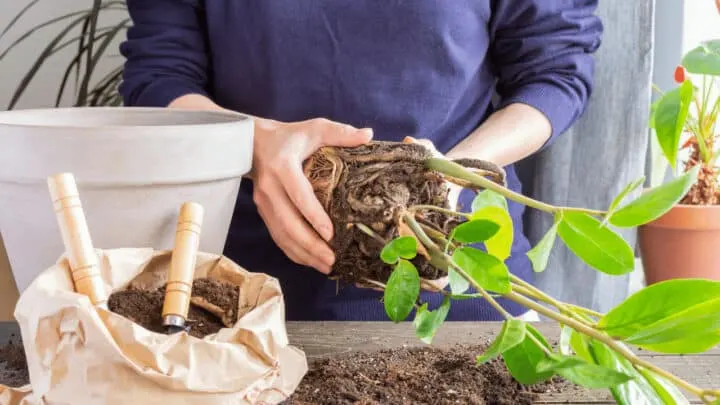
For soil, use a mix of perlite and horticultural soil.
Alternatively, you can mix perlite, coconut husk, and coconut fiber.
The ideal mix for this plant is airy and draining well.
In addition, the soil mix should not hold too much moisture for an extended time, as this might lead to root rot.
It needs well-draining soil, such as coconut fiber, husk, and perlite.
Read more about the ideal soil mix for a ZZ plant.
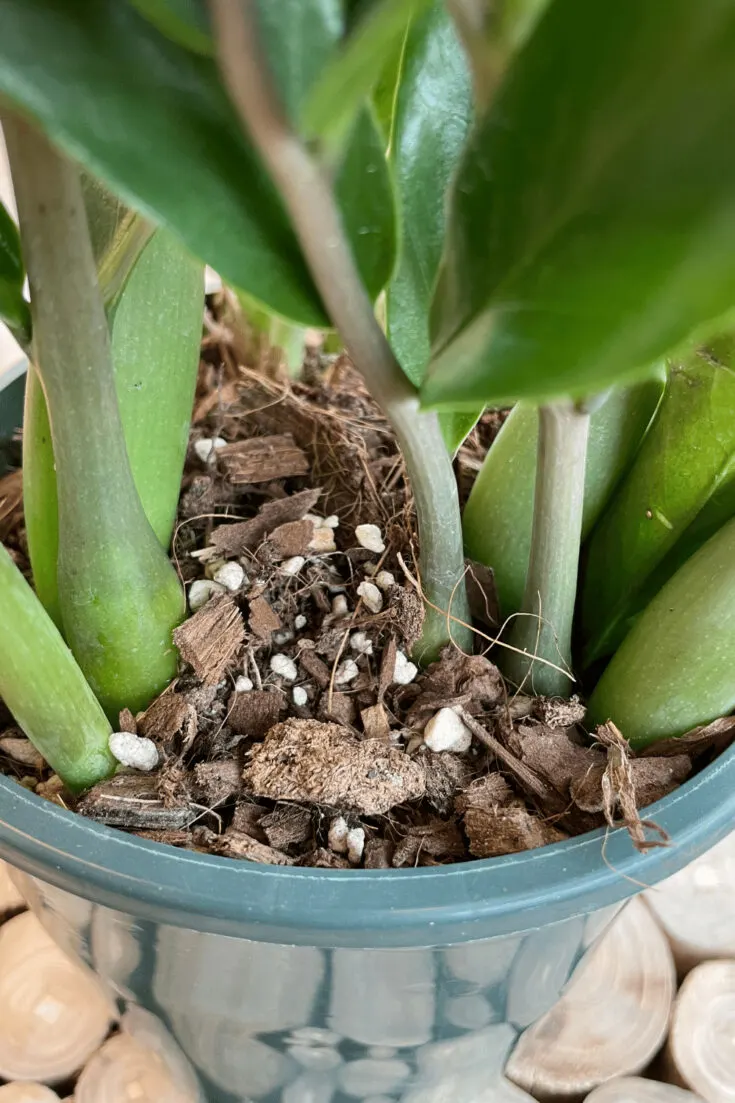
Light
ZZ plants grow best in bright indirect light but will also survive in lower light conditions. ZZ plants can survive in low light conditions; they prefer bright, indirect light. It doesn’t need a lot of light to thrive.
However, provide a ZZ plant with bright indirect light in an east or west-facing window. South-facing windows are also fine. They will grow faster that way.
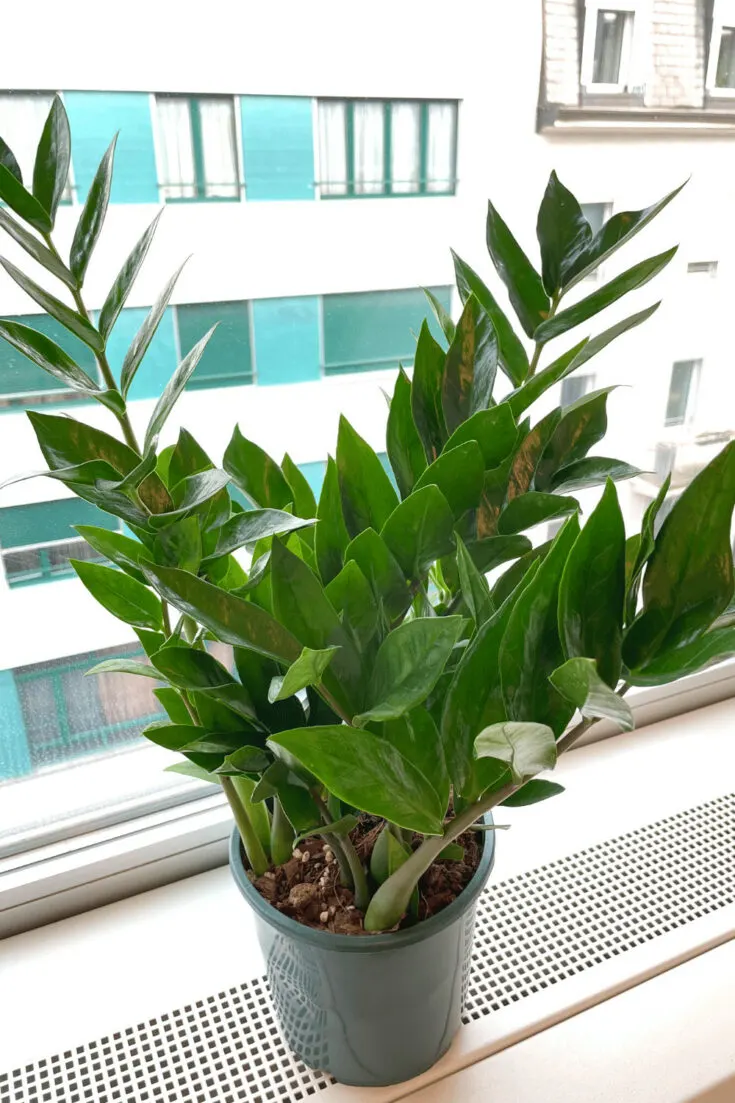
To provide indirect sunlight, place the plant in front of a window covered with a sheer curtain, in front of a window with a northern exposure, or a few feet away from a sunny window.
They can even thrive under bright, fluorescent light. ZZ plants do not like direct sunlight.
Outdoors, the plant grows well in a location with morning sunlight and afternoon shade or in bright indirect light.
Too much exposure to sunlight can cause leaves to get dried out or scorched.
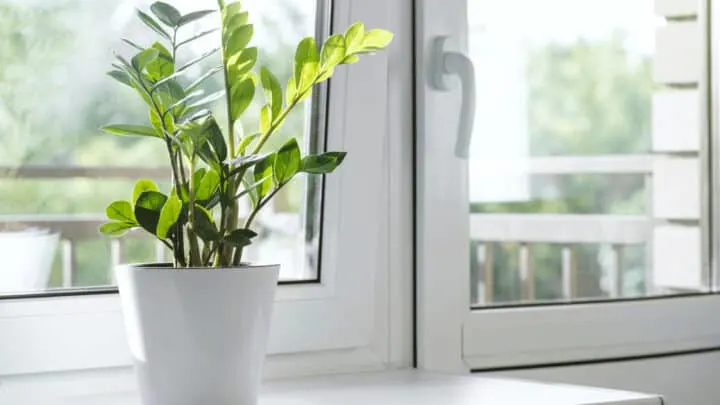
You can find a detailed guide about how much light a ZZ plant needs here.
Water a ZZ Plant
Water a ZZ plant about once a month in spring and summer or every two weeks if it is in a very bright spot. Let the soil dry out completely in-between waterings.
The ZZ plant tolerates drought and can survive a long time without water. It grows thick rhizomes underground. The rhizomes store water.
This plant will forgive you if you forget to water once or twice, but it will not forgive you if you water too often.
If you overwater one to two times are sufficient to cause yellow leaves. In addition, the stems become soft and start rotting.
Reduce watering in autumn and winter or if the ZZ plant receives little light.
It will grow slower in these conditions and will need less water.
In terms of water, soft water is preferred.
Especially rainwater, reverse osmosis water, and distilled water is working fine.
When tap water is used, allow it to sit for some time for the chlorine to evaporate.
You might ask yourself: How often do I need to water my Zamioculcas Zamiifolia?
During fall and winter: Minimize watering the plants and wait for the soil to get dried before watering. This will warm up the water and won’t cause a cold shock.
During spring and summer: Ensure the soil is not moist anymore when watering and check if the water drains properly.
Water the plants deeply enough to saturate the roots and allow the soil to dry before watering again. The plant doesn’t tolerate constantly soggy soil.
How can you know that you are underwatering my Zamioculcas Zamiifolia?
Underwatering ZZ plants results in dry, crispy tips on the leaves. If this is the case, prune your plant and enhance the watering frequency.
How can you know that you are overwatering your Zamioculcas Zamiifolia?
Overwatering ZZ plants results in the yellowing of leaves and mushy brown stalks.
Another indication of overwatering is dropping leaves.
Prune your plants and hold on for watering.
When the soil gets completely dry through the pot, it’s time to water them. This may take up to a month.
The ZZ plant has stunning dark green foliage and thrives on neglect, from my personal experience.
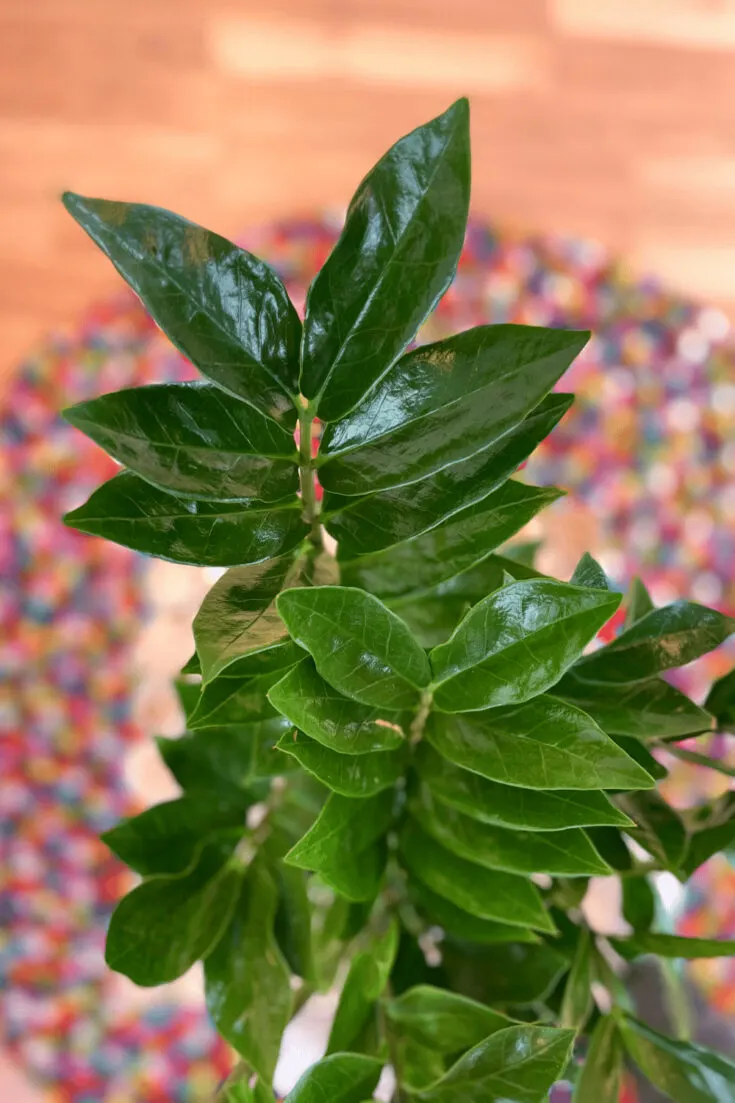
The best watering methods are explained in this article.
Temperature
ZZ plants prefer an average room temperature between 65 – 75 degrees Fahrenheit (18-24 degrees Celsius). General household temperatures are sufficient.
Stunted growth can happen if the average room temperature drops below 45 degrees Fahrenheit (7 degrees Celsius).
Keep temperatures above 65 degrees Fahrenheit for optimal growth (18 degrees Celsius).
The ZZ plant is not frost-hardy.
ZZ plants are hardy down to USDA hardiness zone 9.
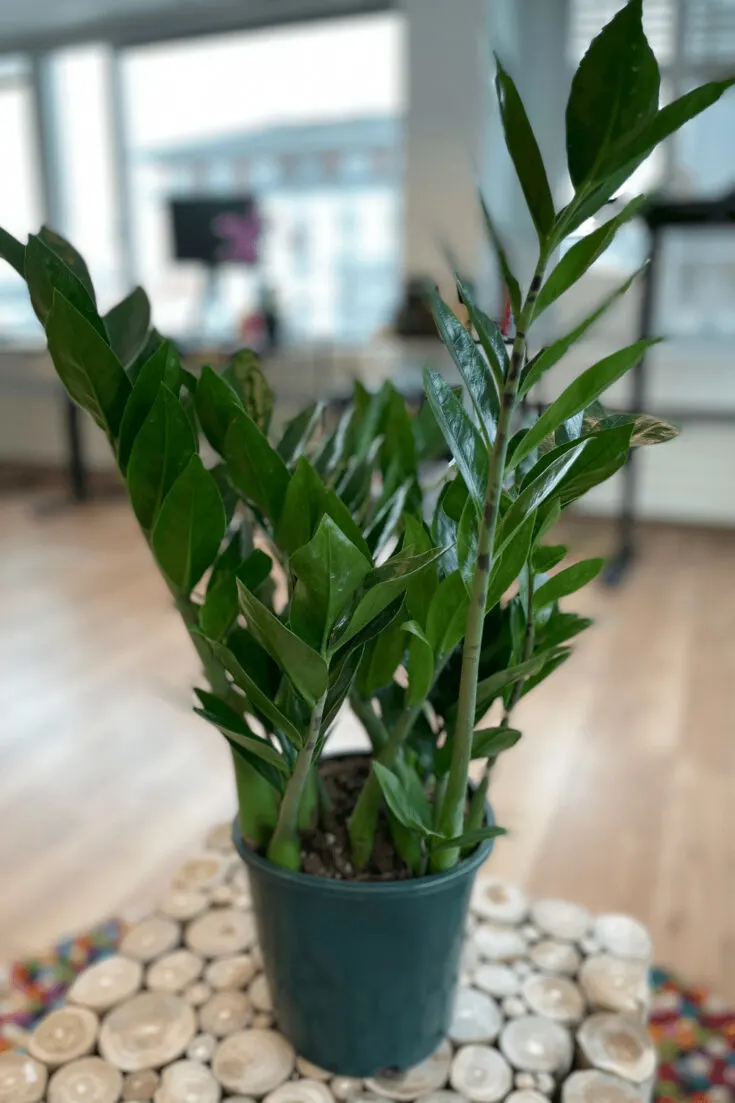
Humidity
ZZ plants do best in low humidity of 40-50%. They grow well in general household humidity.
If the humidity is too high, say 60% or more, it can lead to problems.
Rotting might start, and the ZZ plant might become more susceptible to houseplant pests.
Fertilizer
Use a diluted balanced liquid fertilizer once a month to feed the ZZ plant during the main growing season (April to August). It’s a good idea to dilute (diluted by half) the fertilizer and feed at the time of watering to prevent fertilizer burn.
I do not fertilize in autumn and winter. If you want to fertilize, reduce fertilizing to every 2-3 months.
An argument for fertilizing can be that you want to try to max out the growth potential of the ZZ plant in the colder seasons.
ZZ plants are growing tubers that can be used for propagation.
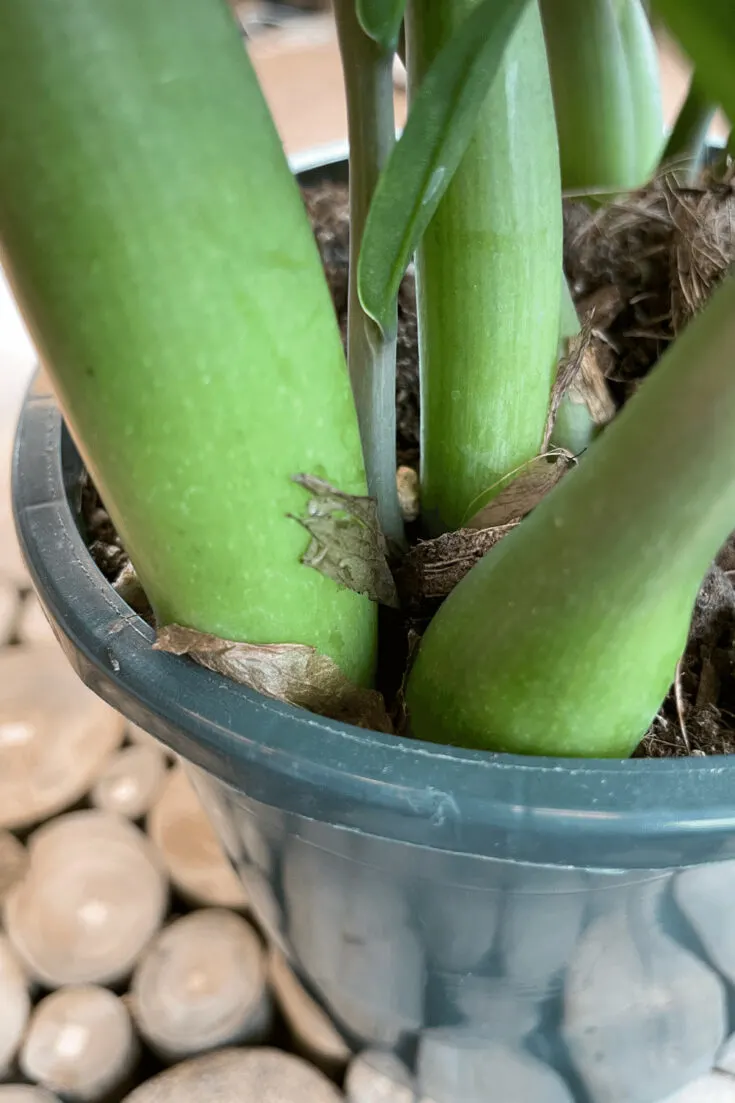
Zamioculcas Zamiifolia Growth
The ZZ plant grows up to 5 feet (152 cm).
When enough rhizomes are planted together, they mature faster and allow the plant to grow to a height of 10 inches in a year (25cm).
Then it continues growing until it reaches its full height.
The dark green leaves and stems grow slowly.
Read more about how fast a ZZ plant grows.
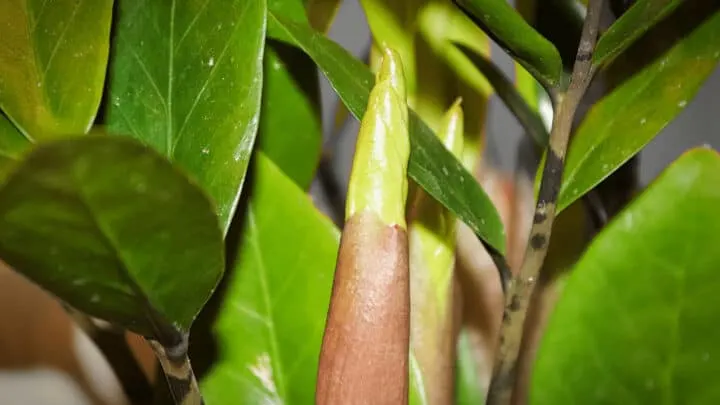
Potting (Pot)
Repot every 2 to 3 years and use a slightly larger pot. Spring is the best season for repotting. Generally, a pot with 2-3 inches more diameter is optimal (2.5-5cm).
Upon buying, repot the plant if the pot is too small. This helps the plant to grow more adequately.
Repotting
To repot, avoid choosing a much bigger pot than your previous pot, as this may drown the plant’s roots.
You may repot in the same vessel, trimming away some foliage and roots and providing new soil if you prefer to maintain the plant’s current size.
Summer or spring is the best time to repot as the plant is at its strongest.
For smaller plants, repotting can be done every 12 to 18 months. You may choose a potting vessel that is 1 to 2″ larger in diameter than the previous one to allow for the proper growth of your ZZ plant.
Avoid choosing a much bigger pot than the previous one, as this could drown your plant’s roots.
You may repot in the same vessel, trimming away some foliage and roots and providing new soil if you prefer to maintain the plant’s current size.
Summer or spring is the best time to repot as the plant is at its strongest.
Here is when and how to repot a ZZ plant.
Propagate ZZ Plants
The ZZ plant can be propagated from leaf cuttings and by division.
When dividing a ZZ plant, you are dividing it into 2 or 3 smaller plants.
However, this shouldn’t be done often as the rhizomes are known to grow slowly.
The other propagation method is to stick a mature leaf in the soil and wait for roots to form.
ZZ plants can also be propagated from leaf cuttings.
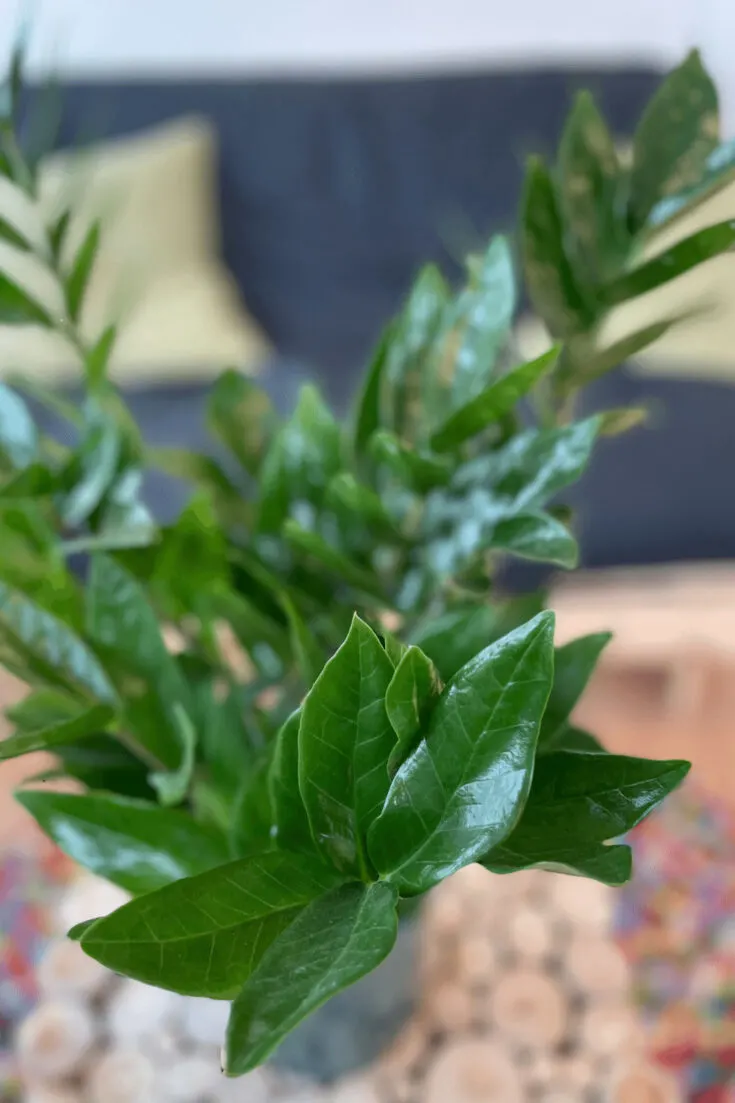
Zamioculcas zamiifolia is a slow-growing, reliable performer that is easy to propagate.
But, propagation can take up to 9 months or even more. It grows from thick, large rhizomes.
Propagating Zamioculcas Zamiifolia is as easy as separating these rhizomes; otherwise, rooting leaf cuttings are the best option.
Propagation through division cannot be done frequently because the plants produce rhizomes slowly, and removing them frequently can damage the parent plant.
Yet another way of propagation is stem cuttings in water.
In general, vegetative single-leaf cuttings are best for propagation.
The best thing is that these indoor plants have an unusual trait of rooting.
They can root with or without a node attached to the leaf-cutting.
Read more about how to propagate a Zamioculcas zamiifolia.
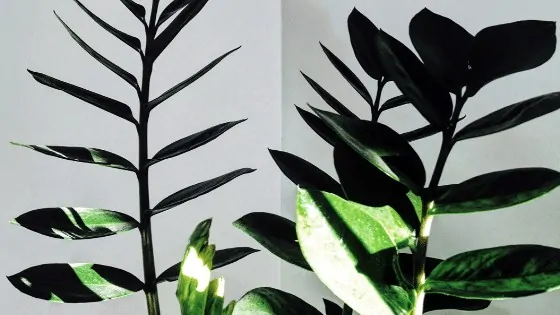
Propagate ZZ plant from leaf cuttings
Step: 1
Pinch off a few leaves from a mature Zamioculcas Zamiifolia and place the leaves on a piece of newspaper or paper plate for one to two hours. This allows the wounded portion of the leaf stems to get callous before propagation.
Step: 2
Fill in a pot with good, damp potting mix and press down each leaf into the soil, stem side down. The leaves of ZZ plants should stay upright, with several inches of space between them.
Step: 3
Keep the pot in a place that receives at least eight hours of bright, indirect sunlight. Place the pot on a plant heating pad maintained at a temperature of 65 to 75 degrees Fahrenheit (18-25 degrees Celsius).
Step: 4
Frequently check the dampness of the soil by pressing your fingers to a depth of 1 inch. If the soil looks dry, spray the soil (not the leaf) with water.
Step: 5
Continue providing damp soil, warmth, and bright light to the ZZ plant leaves.
After you’ve done this, one of three things will happen eventually.
1. You may find a new stem emerging from the side of the leaf you planted. That is a good sign as it means your new plant is on its way. However, it may take a minimum of 16 weeks, so patience is the key.
2. You will notice that the leaf propagation is not going according to plan. Gently pull off the leaf from the soil, and you may find small tubers at the lower end. This is the plant’s energy and water storage. Put back everything into the soil, and hopefully, the tubers will push up new growths.
3. The leaf is dead, and when you pull it out from the soil, there is nothing to see. Propagating your ZZ has failed this time, but take it easy, please. Give it another shot eventually. It will surely be a success next time around. Fingers crossed.
Here is a full guide on propagating ZZ plants from leaves.
Zamioculcas Zamiifoliais as an Air Refresher
According to a study from the University of Birmingham, the ZZ plant is great at cleaning the air and removing benzene, toluene, ethylbenzene, and zylene and is considered a “clean air houseplant.”
The Zamioculcas Zamiifolia has been mentioned in the NASA Clean Air Study conducted in 1989.
But let’s face it.
Suppose you read that story clearly and investigate a bit more. In that case, you find out that you would probably need a whole forest of Zamioculcas Zamiifolia and other plants to clean the air effectively.
5 Tips to Keep A ZZ Plant Healthy
1. Water your Zamioculcas Zamiifolia regularly, but not too much so that it becomes wet or soggy. Soak the soil surface once every week or two weeks, and do not water them until the soil gets dry 1 inch below the soil surface. The best way to kill ZZ plants is by overwatering them.
2. Wipe dust from the Zamioculcas Zamiifolia’s leaves using a soft, damp cloth once every week or every two weeks. This promotes aspiration and keeps the leaves smooth, shiny, glossy, and attractive. Avoid all sorts of commercial leaf-shining products on this plant.
3. Avoid direct sunlight and very dark areas. If the sun is intense through your windows, use a sheer curtain to minimize the light.
4. Keep your Zamioculcas Zamiifolia’s home environment as stable as possible. As with any tropical plants, extreme temperatures can stress them out. Maintain temperatures between 65 and 75 degrees Fahrenheit and avoid keeping them near forced air vents, A/C units, or radiators.
5. Use fertilizers once a month but only when the plant is growing. It’s fine even to skip the fertilizer. If you do feed the plant, though, make sure not to overdo it because this can harm your leafy friend. Dilute the fertilizer before use.
4 Signs A ZZ Plant is Unhappy
ZZ plants are generally easy-going plants and pest-free.
However, Zamioculcas Zamiifolia can get mealybugs. Treat pests immediately with regular wipe-downs of the plant and weekly sprays of horticultural oil (neem oil).
1. Yellowing leaves: Yellow leaves on a ZZ plant are typically caused by too much water. Too much water logging in the soil causes the rhizomes to rot from fungal development.
2. Leaves are curling: Curling leaves may indicate too much light. If curling occurs, then it means that the plant is trying to move away from the light source. To avoid this, move the plant to a shadier location or filter the light using sheer curtains or blinders.
3. Leaf drop: Prolonged watering can cause leaves to droop shed, a survival mechanism. By shedding leaves, the plant minimizes the rate of water loss through them. Overwatering can also cause the tubers to rot, affecting the leaves.
4. Brown and crispy leaf edges: Underwatered leaves exhibit brown and crispy leaves. Soak your plant’s soil with enough water, allow it to drain, and place it back in its growing location.

Plant Maintenance
Every now and then, you will need to clean your plant. The dark green leaves amass a lot of dust. The dust is visible as it contrasts with the green.
It is best to clean a ZZ plant’s leaves frequently with a damp cloth.
Variegated ZZ Plant
Apart from the green version of this indoor plant, there is a variegated ZZ plant. It is rare and hard to find. The price tag is also different. Apart from these differences, plant care is similar but not identical.
Toxicity
This plant is toxic to cats and dogs as well as humans. All parts are toxic and lead to a burning sensation in the mouth, throat, and tongue. It can also lead to swelling, according to the Queensland Government.
Frequently Asked Questions
Where can you buy a Zamioculcas Zamiifolia?
You can buy ZZ plants from anywhere that sells tropical foliage plants. However, if you’re finding it hard to find one in a physical store, you can buy one online. A few options include 1. Amazon: You can buy them on Amazon, and a single live plant typically can cost you from $ 20 to $ 50 2. Etsy: Yet another option to purchase these green beauties is from Etsy, where the price ranges from $30 to $ 55
How popular is the ZZ houseplant?
ZZ plants are quite popular that can be seen and grown indoors all around the globe. It’s adaptability to challenging growing conditions. Its interesting foliage has made it as a decorative piece for interior landscaping around buildings, offices, and homes. It was named Florida Plant of the Year by FNGLA more than once.
What other names does the Zamioculcas Zamiifolia go by?
Zamioculcas Zamiifolia derives its name from how it looks. ‘Zamio’ means that it resembles Zamia, a cycad from Central America, and ‘Culcas’ is an Arabic term that refers to Alocasia/Colocasia. Zamiifolia implies that the leaves resemble Zamia leaves, like fern meets palm tree. Zamioculcas Zamiifolia is such a mouthful that you might prefer to call it by its other names such as ZZ plant, Aroid plant, Zanzibar Gem, Eternity Plant, Money Tree, Succulent Philodendron, Golden Tree, Fat Boy, or just Zu Zu plant.
Why do the leaves of my ZZ plant turn yellow?
Yellow leaves are usually a sign of overwatering. These plants are sensitive to overwatering and should only be watered every four weeks.
How often should I fertilize my ZZ?
Fertilize every 4 weeks in spring and summer.
Can my ZZ plant tolerate extremely low light?
It can tolerate extremely low light. But, this may stunt the growth of your plant. In addition, the risk of overwatering becomes heightened, so be cautious when watering in a low-light conditions.
How often should I repot my ZZ?
For larger floor plants, repotting can be done every 18 to 24 months. You may want to find a potting vessel 2 to 4″ larger in diameter than the previous one to allow for proper growth.
Are ZZ plants poisonous?
ZZ plants are poisonous. All parts of the plant. But, there are also some false rumors that it can cause cancer, so people were so cautious that they wore gloves while handling them. However, the truth is that they are poisonous but not cancerous. So, be cautious and keep it away from overly curious children and nibbling pets, and always wash your hands after handling the plant to prevent skin irritation.
Why does my ZZ plant have such heavy and long stems?
ZZ plants will grow toward light sources. In poor light conditions, the plant’s stems can get stretched or spindled and longer than normal. Rotate the pots once in a while for an evenly spread plant.
I hope this ZZ plant care guide was helpful. Let me know via Social Media how you care for your ZZ plant and what works best for you.

Daniel has been a plant enthusiast for over 20 years. He owns hundreds of houseplants and prepares for the chili growing seasons yearly with great anticipation. His favorite plants are plant species in the Araceae family, such as Monstera, Philodendron, and Anthurium. He also loves gardening and is growing hot peppers, tomatoes, and many more vegetables.

